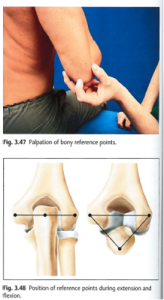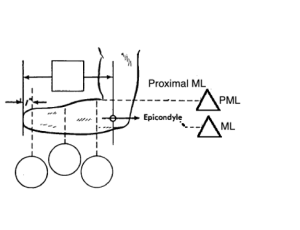7 Socket Impression Techniques
Cast Impression Process
Notice that capturing the impression is step #10 of 11.
1. Prepare and gather materials
- Measurement sheet
- ML gauge and tape measure
- Towels
- Cast sock or nylon (double of the nylon to ease doffing)
- Yates clamps and elastic webbing
- Indelible pencil
- Cast scissors and plaster scissors
- Container for water
- Plaster bandage
- Gown
2. Evaluate the condition of the residual limb
|
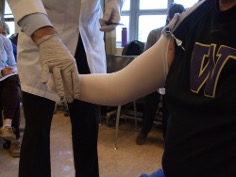
|
3. Take Measurements with elbow at 90’
|
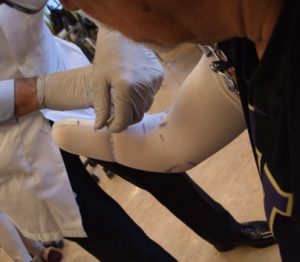 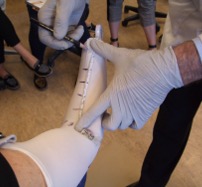 |
4. Prepare rigid plaster splint
|
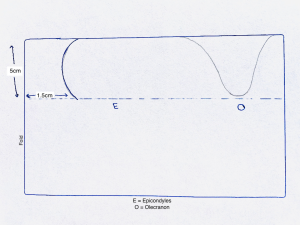 |
5. Prepare the residual limb for casting
- Moisten the casting sock and wring out excess water. Apply the cast sock snugly and use the elastic strap in figure 8 fashion to hold it wrinkle free while the elbow is at 90 degrees.
- Avoid bridging in the cubital fossa
- Use Vaseline on residual limb if hairy.
6. Practice hand position
There are multiple options for hand placement depending on the size of your hands, the size of the patient’s limb and the socket design. The next few slides describe three options to position your hands when casting for a transradial self-suspension prosthesis.
Regardless of the hand position you choose, practice it multiple times before laying the plaster until you feel comfortable and confident that you can reliably capture the anatomy. Assess pressure tolerant areas and potential for suspension.
-
- You want pressure in the supracondylar fossae, on either side of the biceps tendon and on the triceps bar.
- A-P Compression between the ante-cubital fold and the triceps bar
- M-L Compression at supracondylar fossae: anterior and proximal to the humeral epicondyles
- You do NOT want pressure over the bony areas
- You want pressure in the supracondylar fossae, on either side of the biceps tendon and on the triceps bar.
| Hand position 1 | |
|
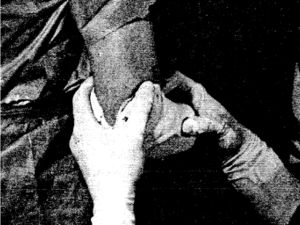 |
| Hand Position 2 | |
|
 |
| Hand position 3 | |
Modified Muenster
Ring fingers or small fingers on the triceps bar |
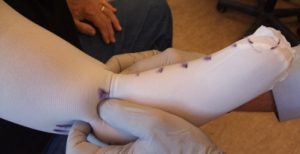 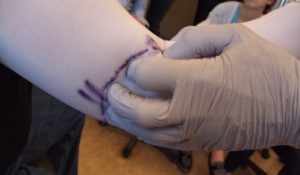 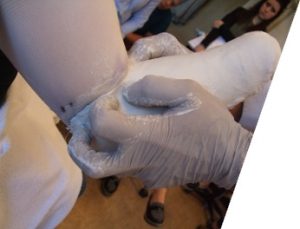 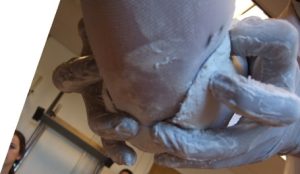 |
7) Consider the following
- Locations of the pressure distribution
- Forces and counterforces in various positions
- Alignment
- Forearm neutral pronation/supination
- Elbow 90’ flexion
- Suspension
- Donning and doffing
8) Mark the landmarks and draw trimlines
With elbow at 90 degrees, palpate the following:
-
- Anatomy: cubital fold, epicondyles, biceps tendon and lateral humeral supracondylar ridge, olecranon, and the electrode sites (as relevant).
- Place your finger and thumb around the residual limb just above the epicondyles into the supracondylar area. Mark the stockinette just above the level of your finger and thumb. Depending on the anatomy, the line is likely 3 cm (1¼”) proximal to apex of epicondyles.
- Place your finger along the triceps bar and mark the stockinette just above the level of your finger. This trimline varies based on the residual limb length but is likely about 2.5cm (1”) proximal to proximal edge of olecranon.
- Put your fingers on the posterior aspect of each epicondyle. Draw the shape of the brim between your fingers.
- Connect the cubital fold line with the medial/lateral marks to complete the brim shape. Be sure to include the supracondylar fossae in the trimlines.
| Medial Trimline | Lateral Trimline | Posterior Trimline | Anterior Trimline |
| Encompass the medial epicondyle at the level of the P-M-L with enough of a brim to flare out of the soft tissue
Standard: 25mm proximal |
Encompass the lateral epicondyle at the level of the P-M-L with enough of a brim and relief for the humerus in the ROM (“fan relief”)
Standard: 25 mm proximal to epicondyle |
Relief for bony pressure on the posterior humeral epicondyles
Trimline should extend about 2.5-5cm above olecranon |
Cubital fold |
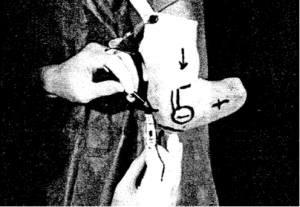
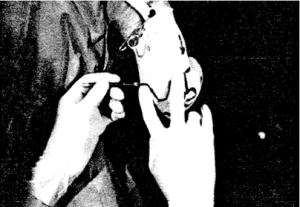
9) Reassess reference anatomy, trimlines, and alignment
Avoid these common errors
- Casting too low (not including the ML trimlines).
- Casting too high over the olecranon.
- Inaccurate limb position (err toward pronation).
- Laying the splint down with too much overlap posteriorly.
- Lack of knowledge about the limb shape (not taking enough time to memorize the feel of the limb).
- Too much plaster (too thick).
- Too little plaster (too thin).
10) Capture the impression
-
-
- Check
- Landmarks and trimlines in appropriate locations and comfort with hand position.
- Supplies: Elastic bandage, splint, rigid bandage, distal end splint, scissors, water located under the arm.
- Pt knows what to expect.
- Alignment
- Moisten the elastic splint and place it on the arm. The first layer should be exactly in the cubital fold and across the olecranon.
- Lay the splint around the limb – cover the olecranon and triceps bar.
- If using the distal end splint, place this on the limb. (Note, that splints are always rigid plaster and they most often need to be secured with a circumferential layer of plaster.)
- Saturate the rigid bandage and wrap proximally to anchor down the splint. Continue wrapping distally to cover the distal end. Wrap once more around the olecranon to secure the rigid splint in place. As you wrap, massage the plaster over the residual limb.
- As you massage, feel the underlying anatomy and the thickness of the plaster.
- Massage the plaster to ensure it is not above or below the pre-determined trimlines.
- Cover the sides of the arm to the height of the trimlines only. Fold the edge of the wet plaster over to match the lines, if necessary. This will add strength to the negative mold.
- Check
-
11) Remove the cast
- To ease removing the negative, pull tissue out of the undercut created by the flexion action.
- Re-check the condition of the residual limb
- Assess the cast impression
- Compare ML measurements at epicondyles and just proximal to epicondyles

